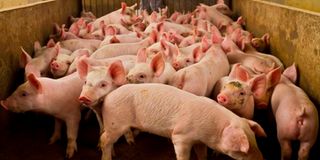What to do when vicious fights break out in pig pen

Pigs in their pen. Crowding and insufficient tryptophan, an essential amino acid, can lead to fights in such a pen. A pig fight can be nasty, leading to deep body lacerations and drawing a lot of blood. Some even end in fatalities.
Pigs generally are gentle and social animals.
When well-fed and kept, they are lovely to watch, especially when young. Their bodies are clean and nicely rounded.
One farmer who kept lots of pigs once told me they provided him psychotherapy just by watching them feed, play and rest every time he came back home from his busy office.
Unfortunately, pigs can be nasty when they do not agree with one another. They can even fight to death.
Betty has been keeping pigs in Kirinyaga county, mostly without many fighting incidents.
But she has witnessed an unusual aggressive behaviour in her animals in the last six months.
The behaviour appears random but I have requested her to track down the breeding history of the affected pigs.
They have of late started fighting and killing selected pigs.
I identified the main cause of the fighting to be crowding and poor ventilation when it started last year.
Betty adjusted the pig numbers in every lot to give at least one square metre per animal.
She also broke down some of the walls of the pens for adequate air circulation.
The problem appeared to be ending but re-emerged with a vengeance in December 2021.
It has spilled into January this year.
The fighting resumed and there does not appear to be a pattern in the affected groups.
The animals are in the porker and grower stages.
The most common cause of fighting in pigs is to establish dominance.
Whenever a new animal is introduced in a pen, it will either be fought by group members and it fights back or it will choose to submit to the authority of the group.
Submitting pigs will lower their heads and rush to a corner or lower the head and hide it away from the snouts of others.
Pigs use their snouts to hit others. They mainly like biting the ears and hitting the body and the neck areas.
A pig fight can be extreme, causing deep body lacerations and drawing lots of blood.
Betty’s pig fights have been as bad as they can be. She has lost at three pigs directly to the fights.
There are others she slaughtered as an emergency to avoid losing them.
When Betty opened the bodies of the dead and badly traumatised pigs, she consistently found fighting had ruptured internal organs.
I have interviewed Betty thoroughly but still have not put a finger on the cause of the bloody battles.
I have also consulted professional colleagues in pig practice to no avail.
The only thing I noted is that Betty has not been using the essential amino acid, tryptophan, in her self-formulated feed.
Its deficiency is thought to indirectly cause aggression in pigs.
Tryptophan is used in the body to produce the hormone serotonin. mencken indent: Insufficiency of serotonin causes mood swings, including depression, anxiety and aggression.
I could not, however, diagnose serotonin deficiency because only pigs in some pens were affected.
Further, I did not have evidence that the pigs had lower than normal levels of serotonin.
I advised Betty to use the amino acid in her feed formulation and observe if there would be a reduction in the fighting.
Boredom is another cause of fights. The animals have a lot of energy and they are inquisitive.
Boredom leads to ear and tail biting. The actions cause bleeding, making the animal appear different from the others.
The pigs curiously bite the bleeding spots, with the affected animal fighting back in self-defence.
That starts the vicious cycle of biting and retaliation before becoming a full scale war.
I advised Betty to increase the number of play chains in the pens to about five pigs per chain.
Chains have been proved to engage pigs in play and dissuade them from fighting.
Stress can also cause fighting in pigs.
It may be brought about by congestion, poor ventilation, poor food quality, unusually loud noises and excessive heat.
The stress causes anxiety and bad mood.
Inadequate feeding space and insufficient food may also lead to fighting.
There, issues appeared well catered for at Betty’s.
Her pigs had been attaining baconer weight within the prescribed six months.
I am still cracking my head on Betty’s case and reaching out to farmers and fellow professionals in animal health to try and identify the cause of the vicious fights on her farm.
I would like to hear from farmers out there if they have similar cases.
I would also appreciate feedback from fellow doctors and paravets if they have experienced the problem.
In the meantime, Betty and I will continue monitoring the situation and hope to unravel the mystery fights on the animal farm.





